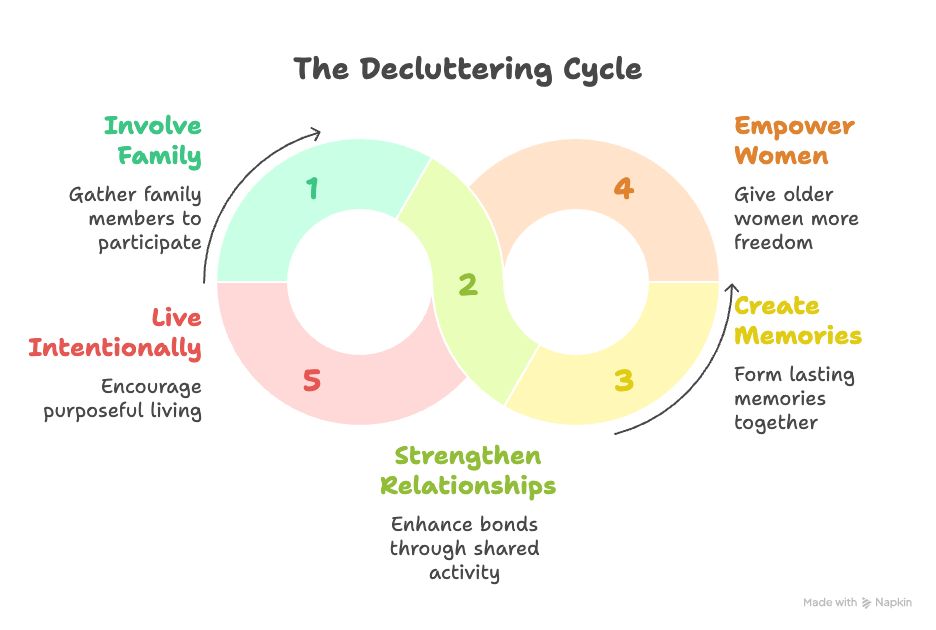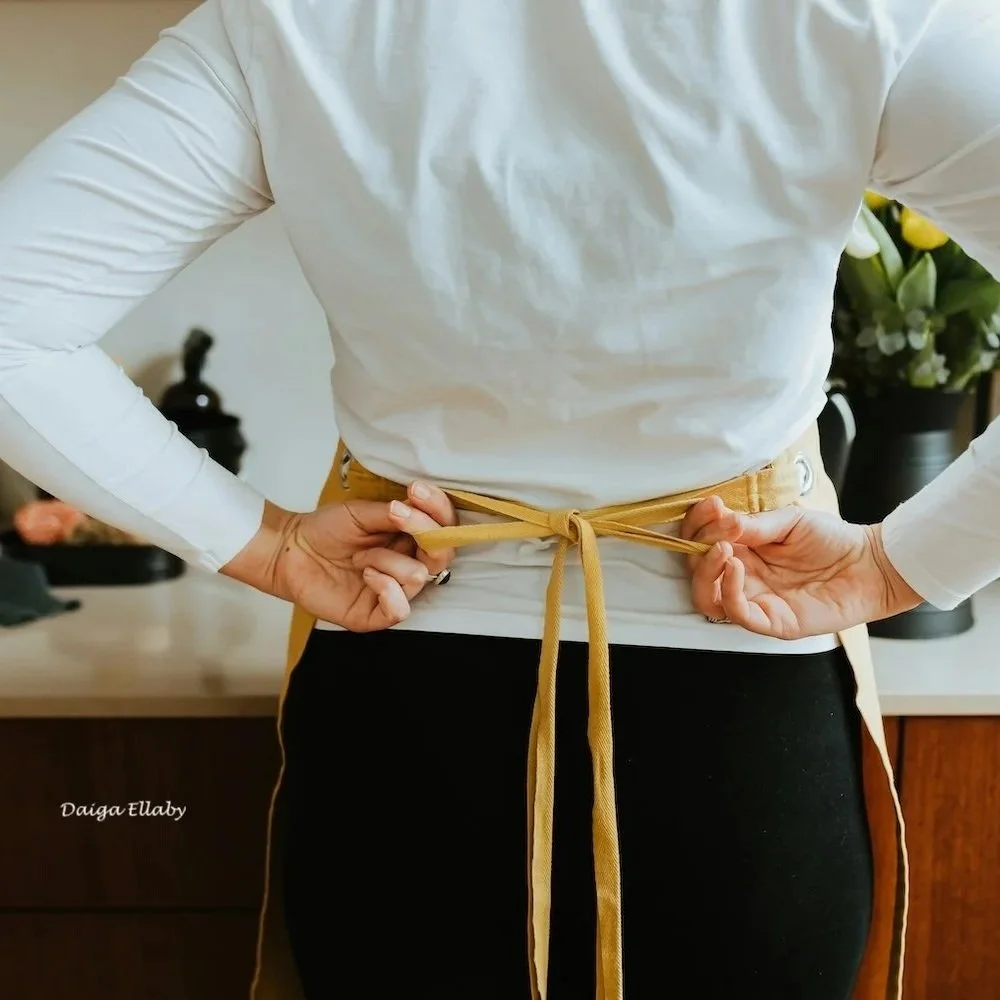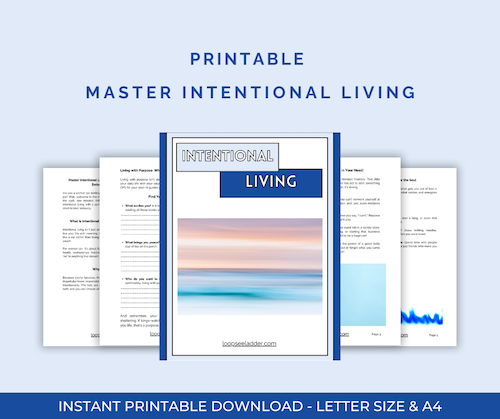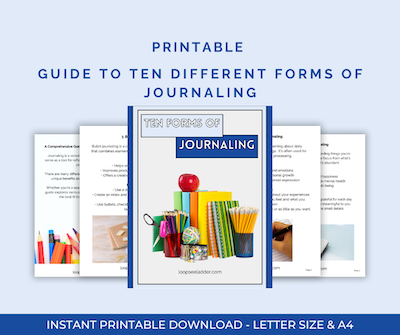Decluttering Strengthens Relationships When Done Together
Decluttering strengthens relationships. It is often viewed as a personal task, but it can also be a powerful social or family activity that creates lasting memories.
Enlisting help in decluttering gives women 55 and older more freedom to live their best lives with intention, purpose, passion, and joy.
Summary: Decluttering is not just a personal task; it can become a potent family activity that strengthens relationships and creates lasting memories. For women 55+, involving family members in decluttering can foster bonding, support legacy planning, and positively impact the community through donations. This blog explores how to transform decluttering into a meaningful social experience, encouraging shared decision-making, celebrating achievements, and giving back to others.
A Preamble - Decluttering Strengthens Relationships
Decluttering is often viewed as a personal task, but it can also be a potent social or family activity that strengthens relationships and creates lasting memories.
When family members are involved in the process, decluttering can be more than just clearing out space—it can foster bonding moments, support legacy planning, and positively impact the community through donations.
In this blog, we’ll explore how to turn decluttering into a meaningful social activity that benefits everyone.
Decluttering is not just a personal task; it can become a powerful family activity that strengthens relationships and creates lasting memories.
For women 55+, involving family members in decluttering can foster bonding, support legacy planning, and positively impact the community through donations.
1. Involving Family: Creating Bonding Moments Because it Strengthens Relationships
Decluttering with family members is a unique opportunity to create bonding moments while working together towards a common goal.
Shared Memories:
Going through old items can trigger memories and stories, allowing family members to reminisce and share their experiences. This can strengthen the emotional ties within the family.Collaborative Decision-Making:
Encourage open discussions about which items to keep, donate, or discard. This collaborative decision-making process teaches valuable lessons about compromise, respect, and understanding.Assigning Roles:
Involve every family member by assigning roles based on their strengths and interests. For example, one person can handle organizing items, while another focuses on sorting items for donation. This approach makes everyone feel included and valued.Celebrating Achievements:
Once a room or space is decluttered, take a moment to celebrate the accomplishment together. Whether it’s a small family dinner or a fun outing, recognizing the collective effort fosters a sense of achievement and togetherness.
Decluttering strengthens relationships with family members and is a unique opportunity to create bonding moments while working together towards a common goal.
We know that decluttering strengthens relationships.
2. Legacy Planning: Decluttering Strengthens Relationships and is a Step Towards Future Generations
Decluttering can be crucial in legacy planning. It can help you decide what to pass on to future generations as family heirlooms and how to do so thoughtfully.
Evaluating Sentimental Items:
Go through sentimental items with family members and discuss their significance. This can be a way to share family history and stories, helping younger generations understand the value of these items.Creating a Legacy Plan:
Consider which items you’d like to pass down to your children or grandchildren as you declutter. Creating a legacy plan can prevent future confusion or disputes and ensure cherished items are passed on with intention.Digitizing Memories:
Consider digitizing photos, letters, or documents to preserve memories while reducing physical clutter. Digital archives can be easily shared with family members, allowing everyone access to important family history.Discussing Future Intentions:
Use the decluttering process to discuss your future intentions with your family. This can include conversations about inheritance, estate planning, and the long-term care of certain items.
Decluttering can be crucial in legacy planning. It can help you decide what to pass on to future generations as family heirlooms and how to do so thoughtfully. Decluttering strengthens relationships.
3. Community Impact: Donating Decluttered Items to Make a Difference
Decluttering benefits you and your family and can also significantly improve your community.
Identifying Local Charities:
Research local charities and organizations that accept donations of clothing, furniture, books, and other items. Donating to these organizations helps support those in need and reduces waste.Hosting a Donation Drive:
Consider organizing a donation drive with your family or neighbours. Collect items from multiple households and donate them to a local shelter, food bank, or community center. This collective effort amplifies the impact on the community.Teaching Generosity:
Involving children in the donation process teaches them the value of generosity and the importance of helping others. It’s a practical way to instill a sense of social responsibility and compassion in younger generations.Tracking the Impact:
Some organizations provide feedback on how your donations are used. Sharing this information with your family can reinforce the positive impact of decluttering and motivate future efforts.
Decluttering benefits you and your family and can also significantly improve your community.
Conclusion: Transforming Decluttering into a Meaningful Family Activity
Decluttering as a social or family activity goes beyond just cleaning out spaces; it’s about creating meaningful experiences, planning for the future, and giving back to the community.
Involving your family strengthens bonds, passes down essential values, and creates a positive impact beyond your home.
Decluttering as a social or family activity goes beyond just cleaning out spaces; it’s about creating meaningful experiences, planning for the future, and giving back to the community.
Involving your family strengthens bonds, passes down essential values, and creates a positive impact beyond your home.
Call to Action:
Are you inspired to turn your next decluttering session into a family event?
Please share this post with friends and family to encourage them to get involved!
Explore our related content for more tips on mindful living, and download our decluttering package to start planning your next family decluttering day.
A Challenge For You:
Approach your supportive family and friends to help with your decluttering project.
Plan when you will get together to work on the project and how you will do the task.
Provide good food and get to work. Music and laughter will help. Get ready for some “feels”.
Celebrate your victories.
You are amazing!
Resources for You:
From YouTube - The Senior Reset: 7 Brutal Decluttering Hacks Seniors Use to Transform Their Homes in 48 Hours
From YouTube - Savvy Senior: 12 Things Older Women Keep Organizing - But Should Declutter Instead!
FAQ
Q: Who is this article for?
A: Women aged 55+ who are ready to clear space (physical and emotional) and strengthen family bonds in the process.
Q: What does making decluttering a family activity involve?
A: It means inviting family members to join you—sorting items together, sharing stories behind them, assigning roles, donating items together, then celebrating the accomplishment as a group.
Q: What are the main benefits covered?
A:
Shared memories and storytelling as you go through old items.
Legacy planning: deciding what items to pass along and why.
Giving back: using donations to support the community and teaching younger generations generosity.
Stronger emotional connections and a sense of achievement together.
Q: Do I need to clear everything at once?
A: No. The article emphasizes a shared, manageable approach—not a rushed purge. The goal is connection and meaning rather than speed.
Q: How will this help me now?
A: You’ll move not just toward a tidier space, but toward more meaningful family connections, a clearer sense of your values and legacy, and the joy of purpose-driven giving and collaboration.
Q: Is this a replacement for professional support (like family therapy or organizing help)?
A: No. This is a lifestyle and relational practice tailored for women 55+. If there are deeper family dynamics, emotional or mental-health issues, professional assistance may still be appropriate.
👉 I thoughtfully use AI tools to polish my writing, but every story comes from my lived experience.



































